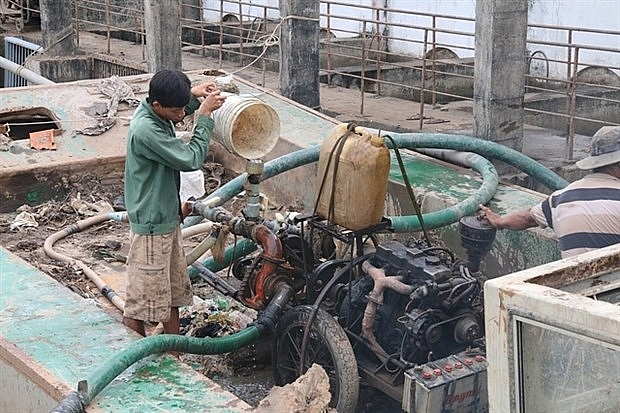Vietnam records nearly 4,000 disasters, incidents in 2019
 |
| Binh Phan pumping station in the Mekong Delta province of Tien Giang has been restarted to ensure water supplies for local paddy fields in response to drought and saline intrusion. (Illustrative image. Source: VNA) |
The figures were announced on January 15 by Deputy Prime Minister Trinh Dinh Dung, who noted that extreme weather events in Vietnam had become more serious and frequent in recent years.
From mid-December 2018 to mid-December 2019, more than 500 people were killed and 170 others injured in environmental incidents. Some 1,400 warehouses and factories and 2,000ha of forest burnt down, while nearly 117,000ha of rice was damaged and 4,000 litres of spilt oil.
In early July, the central province of Ha Tinh was hit by an unprecedented forest fire that covered 92.4ha, destroying nearly 35,200 pine trees and 620 eucalyptus trees in Nghi Xuan district.
Prolonged heat and drought in last year's summer pushed the livestock and crops of thousands of small households in central Vietnam to the brink, prompting the Ministry of Agriculture and Rural Development to urge the Directorate of Water Resources to develop a coping plan for the thirsty winter-spring crops.
From June to October 2019, rainfall in the upper Mekong region dropped by 35 to 40 percent, along with the impacts of El Nino, causing water shortages in the lower part of Mekong River.
The situation was forecast to become more devastating in the next few months, according to the National Centre for Hydrometeorological Forecasting.
The National Committee for Incident and Disaster Response, Search and Rescue mobilised more than 207,000 people for rescue operations, saving more than 5,000 victims and 252 vehicles.
A lack of facilities hindered incident and disaster response, Deputy PM Dung said, including providing early warnings, evacuations, search and rescue, and providing first aid.
Although Vietnam is hit by roughly ten storms a year, the management of fishing boats remains poor, making them more vulnerable to disasters.
He stressed the need for community education and disaster preparations for a proactive response to incidents as well as an increase in investment in innovations to improve forecasting accuracy, prevent incidents and efficiently operate search and rescue activities.
What the stars mean:
★ Poor ★ ★ Promising ★★★ Good ★★★★ Very good ★★★★★ Exceptional
 Tag:
Tag:
Related Contents
Latest News
More News
- Protect what’s next: towards a future free from meningococcal group B disease (December 05, 2025 | 18:00)
- New ILO report offers policy recommendations for disability inclusion (December 04, 2025 | 15:18)
- Maternal job loss may affect children’s mental health, research shows (December 03, 2025 | 19:11)
- Women lead Vietnam’s shift to climate-resilient agriculture (December 03, 2025 | 19:10)
- Experts highlight unpaid care work as key barrier to gender equality (December 03, 2025 | 15:15)
- Opportunities and inequalities for women workers in Vietnam's garment industry (December 03, 2025 | 09:00)
- Vietjet flights carry love to devastated central region (November 28, 2025 | 11:35)
- New initiative to boost the fight against domestic violence (November 26, 2025 | 10:00)
- South Korea funds IOM relief for Vietnam’s typhoon-affected communities (November 24, 2025 | 15:33)
- AI and human-centred values set to shape the future of HR in Vietnam (November 21, 2025 | 18:04)























 Mobile Version
Mobile Version